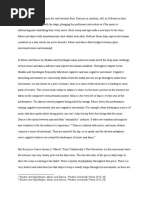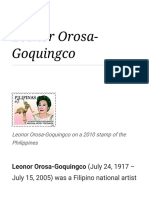Pas " and Is "Typically A Short Number Which Serves As An Introduction For The Suite,"
Pas " and Is "Typically A Short Number Which Serves As An Introduction For The Suite,"
Uploaded by
AeFondevillaCopyright:
Available Formats
Pas " and Is "Typically A Short Number Which Serves As An Introduction For The Suite,"
Pas " and Is "Typically A Short Number Which Serves As An Introduction For The Suite,"
Uploaded by
AeFondevillaOriginal Title
Copyright
Available Formats
Share this document
Did you find this document useful?
Is this content inappropriate?
Copyright:
Available Formats
Pas " and Is "Typically A Short Number Which Serves As An Introduction For The Suite,"
Pas " and Is "Typically A Short Number Which Serves As An Introduction For The Suite,"
Uploaded by
AeFondevillaCopyright:
Available Formats
Aegina Festin
2012-51175
A Reaction: A Christmas Carol
The show started with the singing of the national anthem of the Philippines,
which was followed by a short introduction of what the story A Christmas Carol is
about, including some notes in vocabulary used along the entire play and the context
of time whence Charles Dickens wrote it. Jean Marc Cordero, was the one who
acted as Ebenezer Scrooge, an amateur ballet dancer compared to his colleagues
who played the same role, Nonoy Froilan and Butch Esperanza, on December 8
(14:00) last year. The production employed a music collage, employing a wide range
of themes, made up of twenty-three pieces (It would be better though if I mention
only a few rather than mentioning all the songs) like Pocket Calculator and
Possessed both by Balanescu Quartet, and We Wish You a Merry Christmas by
the Philadelphia Orchestra and Chorus.
The entre, or the opening number in a suite of dances known as the Grand
Pas and is typically a short number which serves as an introduction for the suite,
was done with harmony of the two extremities, the dark and the light. It showcased
the dancing bright red lights accompanied by a fast rhythmic instrumental music,
with the blackness backdropping the entire scene. This was followed by another
entre, which basically introduced the characters of the story, focusing on the
entrance of Ebenezer Scrooge, with a smooth flow to the first real scene of the
storymissing out the usual tradition of classical ballet where the adagio (this is
where the female dancer is partnered by the lead male dancer, or one or more
suitors, or both) follows next to the entre.
The dancers were not synchronized as they should have been in a perfect
performance, unlike those traditional ballerinas of the West, at least, who sway and
glide in harmony with each other. The movements alone were not able to narrate the
story as it still needed words. The good side was that they were smiling in grace
from the start until the end of their performance (Of course they would also frown
depending on the scene). Otherwise it would be very dull as they did not dance with
the musicthe stage had its own subtitles installed and hanged from the central
arch of the proscenium, showing the dialogues of each character, which s/he should
have interpreted through dance. Theatrical ballet must be a pure interpretative
dance, without any incorporated verbal communication, in which its value can be
measured by many factors including how effective it is in conveying the story and
expressing feelings to its audience. It offers no accuracy though, so precision can be
a good gauge.
In terms of harmony, as how Taoism puts it: light and dark, masculinity and
femininity, and birth and death are interrelated; one can exist not without the other
and they are not static, the balance ebbs and flows between them... This is the
same with dance. The principal dancer is in harmony with the danseurs, which
nevertheless was executed quite well by Ballet Philippines, but this was seen not
among the danseurs themselves. If there was no harmony within the light, how could
it be in harmony with the dark? Said in much simpler words, opposite attracts. There
is chaos in light which is antipodal to the pacific dark, so everything fits perfectly in
Taoism. To reiterate, the principal dancer and the danseurs are in harmony.
You might also like
- Reflection Paper - 5 Ballet Pieces AnalysisNo ratings yetReflection Paper - 5 Ballet Pieces Analysis3 pages
- Similarities Between Opera and Chavittu NattakamNo ratings yetSimilarities Between Opera and Chavittu Nattakam3 pages
- The Development of Certain Tendencies in Modern Opera: Thesis for the degree of Bachelor of MusicFrom EverandThe Development of Certain Tendencies in Modern Opera: Thesis for the degree of Bachelor of MusicNo ratings yet
- French 17th Century Operatic LAMENTS and MADSCENESNo ratings yetFrench 17th Century Operatic LAMENTS and MADSCENES152 pages
- Performance Report: Symphonic Dances From West Side StoryNo ratings yetPerformance Report: Symphonic Dances From West Side Story3 pages
- Palm-Of-The-Hand Tales: The Batrachomyomachia Basile'S PentameronNo ratings yetPalm-Of-The-Hand Tales: The Batrachomyomachia Basile'S Pentameron5 pages
- To Speak Is To Sing (2022) - Benjamin GabbayNo ratings yetTo Speak Is To Sing (2022) - Benjamin Gabbay27 pages
- 10 Musical Masterpieces An Entry Point Into Classical Music (Jared Staudt)No ratings yet10 Musical Masterpieces An Entry Point Into Classical Music (Jared Staudt)5 pages
- Tango Buenos Aires (TANGO FUEGO Y PASION)No ratings yetTango Buenos Aires (TANGO FUEGO Y PASION)3 pages
- Christmas Plays by Oberufer:: the Paradise Play, the Shepherds Play, the Kings PlayFrom EverandChristmas Plays by Oberufer:: the Paradise Play, the Shepherds Play, the Kings PlayNo ratings yet
- Scores For The Season of Light: December Repertoire (International Choral Bulletin, 2008 v4)50% (2)Scores For The Season of Light: December Repertoire (International Choral Bulletin, 2008 v4)7 pages
- Who Bridges The Transition of Classical Music To Romantic Music?No ratings yetWho Bridges The Transition of Classical Music To Romantic Music?58 pages
- Waltz of The Flowers From The Nutcracker Suite: by Peter Ilyich Tchaikovsky (1840-1893)No ratings yetWaltz of The Flowers From The Nutcracker Suite: by Peter Ilyich Tchaikovsky (1840-1893)4 pages
- Andris Nelsons Starts New Chapter For Boston Symphony Orchestra - Music - The Boston GlobeNo ratings yetAndris Nelsons Starts New Chapter For Boston Symphony Orchestra - Music - The Boston Globe3 pages
- Vocal Mastery Talks with Master Singers and Teachers, Comprising Interviews with Caruso, Farrar, Maurel, Lehmann, and OthersFrom EverandVocal Mastery Talks with Master Singers and Teachers, Comprising Interviews with Caruso, Farrar, Maurel, Lehmann, and OthersNo ratings yet
- Musical Theater History: The Origins of TheaterNo ratings yetMusical Theater History: The Origins of Theater6 pages
- Music10lesson1philippineoperasandmusicalplays 190205145441No ratings yetMusic10lesson1philippineoperasandmusicalplays 19020514544122 pages
- Einstein, A. (1949). The Italian Madrigal, Volume 1. Princeton U. P.-263-273No ratings yetEinstein, A. (1949). The Italian Madrigal, Volume 1. Princeton U. P.-263-27311 pages
- Leonard Bernstein - An American Musician by Allen Shawn (DR - Soc)100% (4)Leonard Bernstein - An American Musician by Allen Shawn (DR - Soc)359 pages
- American Record Guide Review - Malek JandaliNo ratings yetAmerican Record Guide Review - Malek Jandali3 pages
- Steam Distillation of Cloves READ:Landgrebe 4 Ed .p160-161 (Section 7.6) and p369-371, 5 Ed. P 140-141 (Section 7.6) and P 321-322No ratings yetSteam Distillation of Cloves READ:Landgrebe 4 Ed .p160-161 (Section 7.6) and p369-371, 5 Ed. P 140-141 (Section 7.6) and P 321-3224 pages
- C Sensors: Item Code: 570000447 Part Number:10 LDR 10mmNo ratings yetC Sensors: Item Code: 570000447 Part Number:10 LDR 10mm2 pages
- Speech Plan Title: Specific Speech Purpose: I Would Like To Inform The Class About The Man I Love and ToNo ratings yetSpeech Plan Title: Specific Speech Purpose: I Would Like To Inform The Class About The Man I Love and To1 page
- Evaluation A:: by A Math or Science ProfessorNo ratings yetEvaluation A:: by A Math or Science Professor2 pages
- Reaction To The Visits in National Museum, Casa Manila and St. Agustin ChurchNo ratings yetReaction To The Visits in National Museum, Casa Manila and St. Agustin Church3 pages
- The Republic. Plato.: Purchase The Entire Coradella Collegiate Bookshelf On CD atNo ratings yetThe Republic. Plato.: Purchase The Entire Coradella Collegiate Bookshelf On CD at299 pages
- Longmont Senior Services GO Catalog, Winter 2013 and 2014No ratings yetLongmont Senior Services GO Catalog, Winter 2013 and 201460 pages
- Wishing You Were Somehow Here Again: From The Phantom of The OperaNo ratings yetWishing You Were Somehow Here Again: From The Phantom of The Opera4 pages
- In An Ocean of Emotions Philippine DramaNo ratings yetIn An Ocean of Emotions Philippine Drama21 pages
- Neifert Enrique: 5'10" - 235 Lbs. - Hair & Eyes: Brown Tenor/Baritone With Belt and Operatic Voice (F2-A 5)No ratings yetNeifert Enrique: 5'10" - 235 Lbs. - Hair & Eyes: Brown Tenor/Baritone With Belt and Operatic Voice (F2-A 5)2 pages
- The Following Are The Math Questions in 2017 Civil Service ExamNo ratings yetThe Following Are The Math Questions in 2017 Civil Service Exam23 pages
- Film Year Awards Nominations: The ArtistNo ratings yetFilm Year Awards Nominations: The Artist47 pages
- Shakespeare Lives in Schools Primary Assembly Powerpoint Final 2 0No ratings yetShakespeare Lives in Schools Primary Assembly Powerpoint Final 2 025 pages
- Male Choral Music: Men Resounding (International Choral Bulletin, 2011 v4)50% (4)Male Choral Music: Men Resounding (International Choral Bulletin, 2011 v4)6 pages
- The Spanish Tragedy Essay - Critical Essays - EnotesNo ratings yetThe Spanish Tragedy Essay - Critical Essays - Enotes1 page






































































































